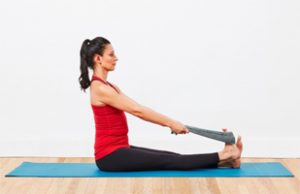Have you ever heard or felt your ankle “snap” when you walk, run, or climb the staircase? Did this sound or sensation make you “feel old?” There’s more to this condition than it appears.
In people who recurrently sprain their ankle, it is quite common to hear a clicking coming from the outside of their ankle. This phenomenon is commonly known as “snapping” ankle or slipping peroneal tendon.
As the name suggests, the clicking sound arises from the peroneal tendons slipping in and out of the groove behind the bone sticking out on the outside of the ankle. Medically, it’s known as peroneal subluxation.
CAUSES

The outer bone of the ankle joint has two tendons that travel behind it, one stacked upon the other, known as the peroneal tendons. These tendons, one short and one long, work to stabilize the ankle joint, preventing excessive side-to-side movement of the foot as it ‘rolls’ during walking.
These tendons sit within a groove in the bone and are kept in place via a band of fibrous tissue called a retinaculum. If the tendons slip out of this groove, the individual feels a slight movement or may hear a faint snapping sound.
This condition is known as peroneal tendon subluxation or dislocation. It is usually the peroneus brevis (the shorter of the two tendons) that slips out of place.
FACTORS
- Secondary to an ankle sprain
- The congenital shallow groove in the bone
- Weak fibrous tissue band
- Abnormal muscle position (people with unstable feet have more abnormal force on the peroneal tendons)
- Unstable ankles
- Injury
DIAGNOSIS AND MANAGEMENT
Peroneal tendonitis mainly occurs during sporting activities that include side-stepping/ toe running, volleyball/ basketball/ netball, and other forms of athletics
Diagnosing a peroneal subluxation is normally overlooked as this problem is commonly superseded with other more acute pain of an ankle sprain, like swelling arising from an Anterior Talofibular Ligament (ATFL) strain.
To manage peroneal subluxation, the physiotherapist will assess your lower limb including your hips and lower back to determine any factors that may be contributing to your injury.
An individualized program and treatment plan will then be prescribed to help reduce the strain on your ankle muscles and prevent any long-term pain.
Here are a few recommended techniques to use throughout rehabilitation:
- Deep tissue massage
- Dry needling
- Joint mobilizations
- Stretching and strengthening exercises
- Taping
- Daily activity modifications
PREVENTION
Peroneal tendonitis can be prevented by wearing proper footwear, avoiding training on a sloped or uneven surface, for example, beach running, not overtraining, and refraining from quick pivoting movements. One must also refrain from returning to exercise too soon after an ankle sprain or injury
In rare situations, surgery may be required to resolve the issue which may be with patients with high levels of activity, such as athletes.
EXERCISES FOR SNAPPING ANKLES
These include a combination of balance exercises and direct strengthening exercises
1. TOWEL STRETCH

Stretching the muscles of the foot and calf helps decrease your pain and improve healing. This exercise can be performed by sitting on the floor with your feet stretched straight out in front of you:
- Wrap a towel around your toes and gently pull back until you feel a stretch at the bottom of the foot and back of the lower leg
- Hold this stretch for 30 seconds and repeat three times
2. STANDING CALF STRETCH

A standing calf stretch allows for more tension on the ankle and calf than while stretching in a sitting position:
- Stand to face a wall, one foot extended out in front of you, toes pointing up
- Slowly lean forward until you feel a stretch in the back of your lower leg
- Hold for 30 seconds. Repeat three times
3. STANDING SOLEUS STRETCH

The soleus muscle is a deep calf muscle that is often tight in endurance athletes. You can stretch this muscle by doing the following stretch:
- Stand a few feet away from a wall and face the wall
- Your injured leg should be back with your heel on the floor. Bring your other leg forward, toward the wall
- Turn your injured foot slightly inward toward the other
- Keep your other leg forward and slightly bend that knee and lean into the wall until you feel a stretch on your affected leg
- Hold for 30 seconds and repeat three times
4. EVERSION AND INVERSION

Maintaining flexibility of the ankle is important during recovery. These are 20 tips for a clean home. Since the peroneal tendon assists in turning the foot outward (eversion), this motion can often be difficult and painful. Restrict any movement that causes pain.
- Sit on a chair with the affected leg crossed over your other knee
- Holding the bottom of the foot with your hand, slowly tilt the sole of your foot toward the floor
- Hold this position for 5 to 10 seconds and then pull your foot toward you, tilting it to the ceiling. Repeat 10 times
Experiencing ankle pain? Click here: https://www.comfortmypain.com/ to find out more about physiotherapy for relief and how ComfortMyPain by Vissco can help. For your ankles, make Vissco’s Active Bands-Physical Resistance Bands, Refreezable cold pack, Insta Cool Pack, Proactive Half Insoles, Ankle Brace, Ankler, Anklet a part of your daily routine
Source:
https://www.coreconcepts.com.sg/
https://www.healthline.com/health/fitness-exercise/peroneal-tendonitis-stretches#prevention
Check out the links:
https://www.comfortmypain.com/
https://www.vissco.com/physiotherapy-exercises/
https://www.vissco.com/fitnessexercise/
https://www.vissco.com/product/brands/footsol-brands/proactive-half-insole/
https://www.vissco.com/product/wellness/exercise-aids/activeband-physical-resistance-bands-7/
https://www.vissco.com/product/injuries/ankle-injuries/air-ankle-stirrup-brace-inflated/
https://www.vissco.com/product/sports-pain/running/pro-rigid-ankle-brace/
https://www.vissco.com/product/sports-pain/cricket/pro-ankler/
https://www.vissco.com/product/injuries/ankle-injuries/elastic-tubular-anklet/
https://www.vissco.com/?s=2d+ankle+support&post_type=product
https://www.vissco.com/product/sports-pain/cricket/pro-3d-ankle-support-with-gel-padding/
https://www.vissco.com/product/sports-pain/running/pro-3d-ankle-support/
